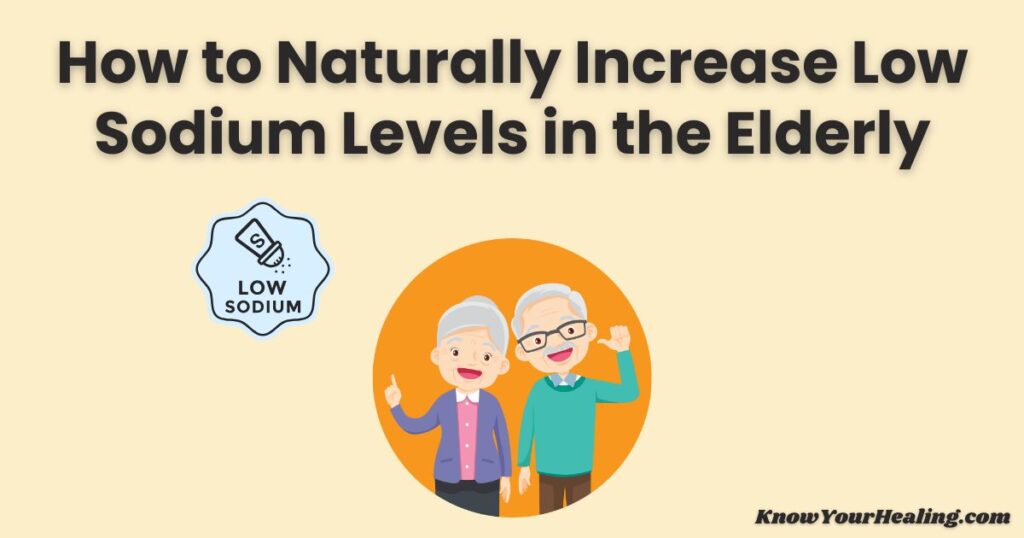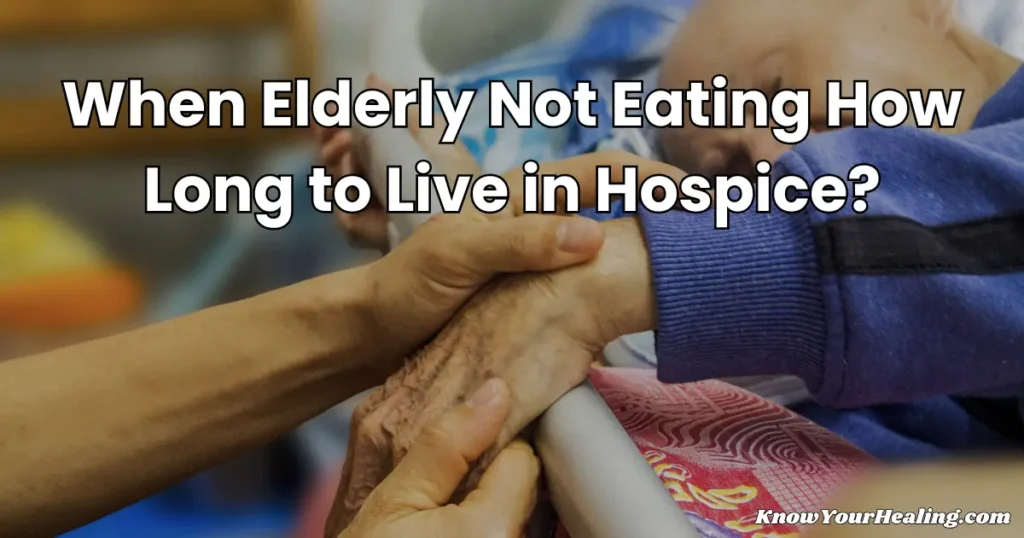Low sodium levels in older adults can trigger serious health risks, like confusion, fatigue, and even dangerous complications if ignored.
Seniors can often naturally boost their sodium levels by making specific dietary changes, maintaining fluid balance, and monitoring their symptoms—without relying solely on medication.
This guide highlights the warning signs of low sodium, shares proven natural methods to restore healthy levels, and explains when it’s time to consult a professional to protect the health and well-being of the elderly.
Understanding Low Sodium Levels in the Elderly

Low sodium affects nearly 20% of older adults and can lead to complications like confusion, fatigue, and a higher risk of falls. Multiple medical conditions, medications, and age-related changes all contribute to this complex electrolyte imbalance.
What Low Sodium Levels Mean for Older Adults
Doctors call low sodium levels “hyponatremia” when blood sodium drops below 135 mEq/L. This messes with fluid balance and vital cellular functions.
Sodium helps nerves function properly and muscles contract. When there’s not enough sodium, cells swell with water, and things can go downhill fast.
The normal sodium range is 135-145 mEq/L. Anything below that means hyponatremia, which can be mild or severe enough to need urgent care.
Chronic hyponatremia sneaks up over weeks or months. It’s subtle at first, but if you miss the signs, it can cause permanent brain damage.
Acute hyponatremia hits fast—within 48 hours. This is a medical emergency that can lead to seizures, coma, or worse if not treated immediately.
Common Medical Conditions That Cause Sodium Imbalance
Specific health problems make hyponatremia more likely in seniors:
| Health Problem / Condition | How It Increases Hyponatremia Risk in Seniors |
|---|---|
| Heart failure | Causes the body to retain water, disrupting sodium balance. |
| Kidney disease | Disrupts hormones that regulate fluid retention, resulting in abnormal sodium and water distribution. |
| Liver disease | Causes the body to retain excessive water, which is more common with aging. |
| SIADH (Syndrome of inappropriate secretion of antidiuretic hormone) | Long-term conditions often require medications such as thiazides and loop diuretics (for high blood pressure) that lower sodium levels. |
| Chronic diseases & certain medications | Long-term conditions often require drugs like thiazide and loop diuretics (for high blood pressure) that lower sodium levels. |
| Severe diarrhea and vomiting | Rapidly depletes sodium; seniors recover more slowly due to less efficient kidney function. |
Symptoms of Low Blood Sodium You Should Not Ignore
Hyponatremia symptoms often creep in and can look like normal aging. Muscle cramps are common, especially at night or after light activity.
Fatigue and weakness often show up early. If these issues worsen, it’s time for a closer examination.
Confusion and memory issues signal more serious hyponatremia. Family members usually spot these changes before the person does.
Headaches that don’t go away with usual remedies can indicate a sodium imbalance. Ongoing nausea and vomiting can both cause and result from low sodium.
Severe hyponatremia can bring on seizures, coma, and even stop breathing. These situations demand emergency care.
Muscle weakness can cause imbalance and impaired coordination, making falls more likely—especially for seniors living alone.
Risk Factors That Put the Elderly Population at Higher Risk
Getting older naturally raises hyponatremia risk because of weaker kidneys and hormone shifts. Seniors also tend to take more medications that mess with sodium.
A strict diet with low sodium intake can lead to deficiencies. Many older adults reduce their salt intake without consulting a doctor, which can be a risky decision.
Drinking too much water can dilute sodium below safe levels. Some seniors believe more water is always better, but it’s not that simple.
A health history of heart disease, diabetes, or kidney issues makes sodium imbalances more likely. These conditions often require meds that further shift electrolyte levels.
Living alone means symptoms might go unnoticed. Isolation can delay getting help when it’s needed most.
How Blood Tests and Physical Examination Detect Low Sodium
Doctors use blood tests to check serum sodium and diagnose hyponatremia quickly. These tests show exact sodium levels within hours.
During physical exams, doctors look for subtle signs, such as changes in mental status or muscle weakness. They often spot these patterns during checkups.
Urine sodium tests help uncover what’s behind the imbalance. These extra studies guide the next steps in treatment.
Regular checkups can catch problems early. Doctors may tweak medications or suggest dietary changes based on test results.
Reviewing blood volume and medical history helps to round out the diagnosis. This thorough approach helps tailor the best plan for treating hyponatremia.
Natural Ways to Increase Sodium Levels Safely

Natural strategies focus on making diet changes and lifestyle adjustments to maintain balanced electrolyte levels. Experts recommend combining sodium-rich foods with smart fluid management to help seniors stay in the healthy sodium zone.
Boost Sodium Intake with Sodium-Rich Foods
Seniors can safely increase their sodium intake by choosing foods packed with both nutrients and natural sodium. Cheese and broth are solid options that don’t rely on dumping salt on everything.
High-Sodium Food Options:
- Cheese: Parmesan, cheddar, and feta deliver a sodium punch
- Broths and soups: Homemade or store-bought, they’re flavorful sodium sources
- Pickled veggies: Olives, pickles, and sauerkraut come with higher sodium levels
- Processed meats: Ham and salami work in moderation, but watch for other health concerns
Cottage cheese offers protein and helps meet daily sodium needs. Convenience foods can fill gaps, but balance them with fresh options.
Doctors often suggest adding these foods slowly. This helps seniors adjust and allows them to monitor how their bodies respond.
Adjusting Fluid Balance to Avoid Dilution of Sodium
Managing fluid intake is crucial for maintaining sodium levels in check. Drinking too much water can dilute sodium levels, especially for individuals at risk.
Doctors recommend tracking water intake, particularly for seniors on loop or thiazide diuretics. These meds shift how the body handles sodium and fluids.
Fluid Management Tips:
- Skip large amounts of water during meals
- Use electrolyte drinks when needed
- Check urine color—pale yellow is usually a good sign
- Adjust fluids based on activity and weather
Family members should notice any significant changes in drinking habits. Conditions like heart failure or kidney disease may need special fluid plans.
Doctors use blood tests to fine-tune fluid advice for each person’s health situation.
Lifestyle and Dietary Changes for Overall Health
Making broad lifestyle changes can help regulate sodium levels and address the underlying causes of chronic hyponatremia. Regular movement keeps muscles and circulation in shape.
Sticking to regular meal times helps stabilize electrolytes—small, frequent meals with moderate sodium work better than big, salty feasts.
Helpful Lifestyle Habits:
- Gentle exercise: Supports healthy blood flow
- Consistent sleep: Helps regulate hormones that affect sodium
- Managing stress: Keeps electrolytes steadier
- Taking meds on schedule: Reduces complications
Doctors may recommend specific diets tailored to a patient’s medical history. Managing chronic diseases often requires the involvement of multiple specialists.
Monitoring Sodium Intake in Milligrams for Better Control
Tracking sodium daily helps seniors stay within the safe range and avoid high blood pressure. Most adults require approximately 2,300 mg per day, although this amount may vary.
Doctors use blood tests to check sodium and adjust diet plans as needed. Regular checkups help catch problems early.
Monitoring Tools:
- Food diaries to track sodium in milligrams
- Routine blood work for electrolytes
- Blood pressure checks for safety
- Symptom logs to spot changes
Seniors should work closely with their doctors to establish sodium goals tailored to their risk factors and health status.
Supporting Muscle Function and Nerve Health Naturally
Getting enough sodium helps keep muscles and nerves functioning properly. Balanced nutrition and gentle movement help maintain these vital functions.
Muscle cramps often signal electrolyte imbalances, which can sometimes be attributed to low sodium levels. Doctors consider these symptoms, along with others, to determine the best treatment.
Natural Support Strategies:
- Balanced meals: Include foods that support all electrolytes
- Light exercise: Keeps muscles strong and blood moving
- Good rest: Helps the body recover and function
- Hydration balance: Avoid both too little and too much water
If symptoms don’t improve with diet changes, it’s time for professional advice. Severe cases, such as confusion or significant muscle weakness, require emergency care.
When to Seek Professional Medical Advice

Raising sodium levels naturally in seniors requires medical supervision when symptoms are severe or persist despite dietary changes.
Doctors play a crucial role in identifying the underlying cause and developing a comprehensive treatment plan that addresses both immediate and long-term needs.
Severe Cases That Require Immediate Attention
Emergency care is a must when seniors show signs of severe hyponatremia that could cause lasting brain damage. Confusion, seizures, or loss of consciousness require urgent attention.
Get emergency help for:
- Intense muscle cramps and weakness
- Trouble breathing or chest pain
- Seizures or shaking
- Significant confusion or sudden mental changes
- Vomiting that stops fluid intake
Acute hyponatremia can happen fast—sometimes after drinking too much water or losing sodium from severe diarrhea. Doctors need to act right away to prevent life-threatening problems.
Blood sodium levels under 125 mEq/L typically indicate the need for hospitalization. Doctors carefully manage fluids during treatment to prevent complications.
How a Healthcare Provider Creates a Hyponatremia Treatment Plan
Healthcare professionals tailor treatment plans for low sodium levels based on the underlying cause and the severity of the condition. Mild and chronic hyponatremia often need very different approaches.
Key components of treatment plans include:
- Blood tests to check sodium levels
- Urine tests to measure sodium loss
- Adjusting medications like loop or thiazide diuretics
- Guidance on how much fluid to drink
- Regular checks of vital signs
Medical professionals seek the biological reasons behind sodium loss by conducting detailed tests. They also review medical history to spot medications or health issues that might be causing trouble.
Treatment may involve gradually replacing sodium through IV fluids or oral supplements. Providers carefully control how fast sodium levels rise to avoid dangerous complications.
Medical Conditions That May Need Targeted Treatment
Some health conditions in older adults make managing low sodium more challenging and require extra attention. Managing chronic diseases here isn’t optional—it’s the only way to prevent more episodes.
Conditions needing targeted treatment:
- Heart failure that disrupts fluid balance
- Kidney disease that affects sodium control
- Liver disease leading to fluid buildup
- Syndrome of inappropriate antidiuretic hormone secretion (SIADH)
- Medication side effects are causing ongoing low sodium levels
Providers focus on fixing the root cause, not just the symptoms. Medical problems often drive hyponatremia in older adults, so it’s rarely a simple fix.
Treatment may include adjusting medications, managing chronic illnesses, or modifying dietary habits to achieve optimal health. Ongoing monitoring helps ensure that sodium levels stay within a safe range.
Importance of Regular Check-Ups for the Elderly Population
Regular check-ups help doctors catch low sodium early and prevent serious problems, especially in older adults. Routine blood tests can spot changes even before symptoms appear.
Benefits of regular monitoring include:
- Finding low sodium before it gets worse
- Adjusting medications as needed
- Checking kidney and heart health
- Reviewing whether dietary sodium changes are working
- Spotting new health risks
Older adults with chronic hyponatremia often need blood tests every few months. Doctors can adjust treatment plans as health or medication changes occur.
Preventive care supports overall health and lowers the chances of complications. Physical exams enable doctors to detect muscle weakness or nerve changes that may indicate potential issues.
How Family Members Can Support Elderly Patients
Family members play a crucial role in recognizing the symptoms of low sodium and ensuring that older loved ones receive the necessary care. They can monitor daily changes and share their concerns with healthcare teams.
Ways the family can provide support:
- Track symptoms and make sure medications are taken
- Offer sodium-rich foods like cottage cheese
- Help manage how much water is drunk each day
- Set up and attend medical appointments
- Ask questions at doctor visits
If diet changes aren’t helping, families should talk to a doctor. They can help stick to treatment plans and report any new problems.
Caregivers need to recognize when natural methods are insufficient. Sometimes, home remedies won’t cut it, and medical treatment becomes necessary.
Frequently Asked Questions
Here are practical answers about managing low sodium in older adults, from safe foods to urgent treatment options. These responses cover dietary tweaks, what to drink, and when to seek medical help.
To address low sodium levels in seniors, doctors may adjust medications or treat underlying health conditions. Sometimes, they’ll limit water or give IV fluids.
Seniors can naturally increase their sodium intake by consuming foods like chicken broth and cottage cheese. Electrolyte drinks, such as Gatorade or Pedialyte, can also help replenish sodium levels.
Treatment depends on the cause, so medical supervision is a must. Some people require adjustments to their medication; others respond better to dietary changes.
Doctors can use IV sodium solutions to raise sodium levels rapidly. This approach works most efficiently and is safest when performed in a hospital.
For mild cases, oral rehydration solutions can be used at home and provide relief within hours. These drinks provide a balanced electrolyte boost.
Salty foods take longer to work than medical treatments. If symptoms are severe, don’t wait—get emergency medical care.
Foods high in sodium can help raise blood sodium. Chicken broth packs 800-1,200 mg per cup and works great in soups.
Cottage cheese contains 400-500 mg of protein per half cup and pairs well with fruit. Canned tuna in brine includes 300-400 mg of sodium per 3-ounce serving.
Pickled veggies and salted nuts add moderate sodium. Protein-rich meals also support healthy sodium levels.
Heart, liver, kidney, and brain diseases often cause low sodium. Hormone problems and certain medications are also common culprits.
Drinking too much water can dilute sodium, especially in older adults. Many seniors over-hydrate, thinking it’s healthy, but it can have unintended consequences.
Medications such as diuretics and antidepressants often lower sodium levels. Age-related kidney changes make it more challenging for the body to regulate sodium levels.
Electrolyte drinks, such as Gatorade and Pedialyte, offer a balanced mix of sodium, potassium, and other essential minerals. They help replenish sodium levels.
Chicken broth counts as both food and drink, providing a solid sodium boost per cup. It’s easy to sip throughout the day.
Homemade oral rehydration mixes, consisting of water, salt, and sugar, are a budget-friendly option. Store-bought sports drinks are convenient, but be sure to check the sugar content.
People with low sodium levels should monitor their water intake rather than avoiding specific foods. Too much plain water dilutes sodium even further.
Foods with very little sodium, such as some processed items, may not provide sufficient benefits. Fruits with high water content, such as watermelon, should be consumed in moderation.
Consuming a lot of caffeine can cause you to urinate more and lose sodium. Alcohol is risky too; it messes with hormone balance and sodium control.
Only take sodium supplements if your doctor says so—dosing mistakes can be dangerous. Healthcare providers determine the safe dosage for each individual.
Salt tablets are available, but they require careful monitoring to prevent overuse. Most doctors prefer food or IV options instead of supplements.
Electrolyte supplements with several minerals are safer than pure sodium pills. These give balanced support without risking sodium overload.
IV fluids are the go-to treatment for severe low sodium levels. Doctors control the speed to prevent dangerous swings.
Treatment depends on the symptoms and the level of sodium in the blood. Milder cases may be treated with oral rehydration and some dietary adjustments.
When confusion, seizures, or severe weakness hit, hospital care is needed. Medical teams follow strict protocols for safe correction.
Moderate coffee consumption typically does not exacerbate low sodium levels. Too much caffeine, though, can increase urination and lead to more sodium loss.
Drinking large amounts of any fluid, including coffee, can dilute sodium levels in the body. Seniors should keep an eye on total fluids instead of cutting coffee entirely.
Adding a pinch of salt to coffee or pairing it with salty snacks helps. The real key? Moderation and a balanced diet.
Recovery time depends on the severity of the low sodium and the underlying cause. If the case is mild, you may notice improvement within 24 to 48 hours with the proper dietary adjustments and careful fluid management.
For moderate or severe cases, doctors take a slower approach—usually spreading the correction out over several days. This approach helps protect your brain from sudden changes.
Your entire recovery hinges on addressing the underlying problem, whether that involves adjusting medications or addressing another health issue. Older adults may require ongoing check-ins and adjustments to their diet to maintain steady sodium levels over time.




